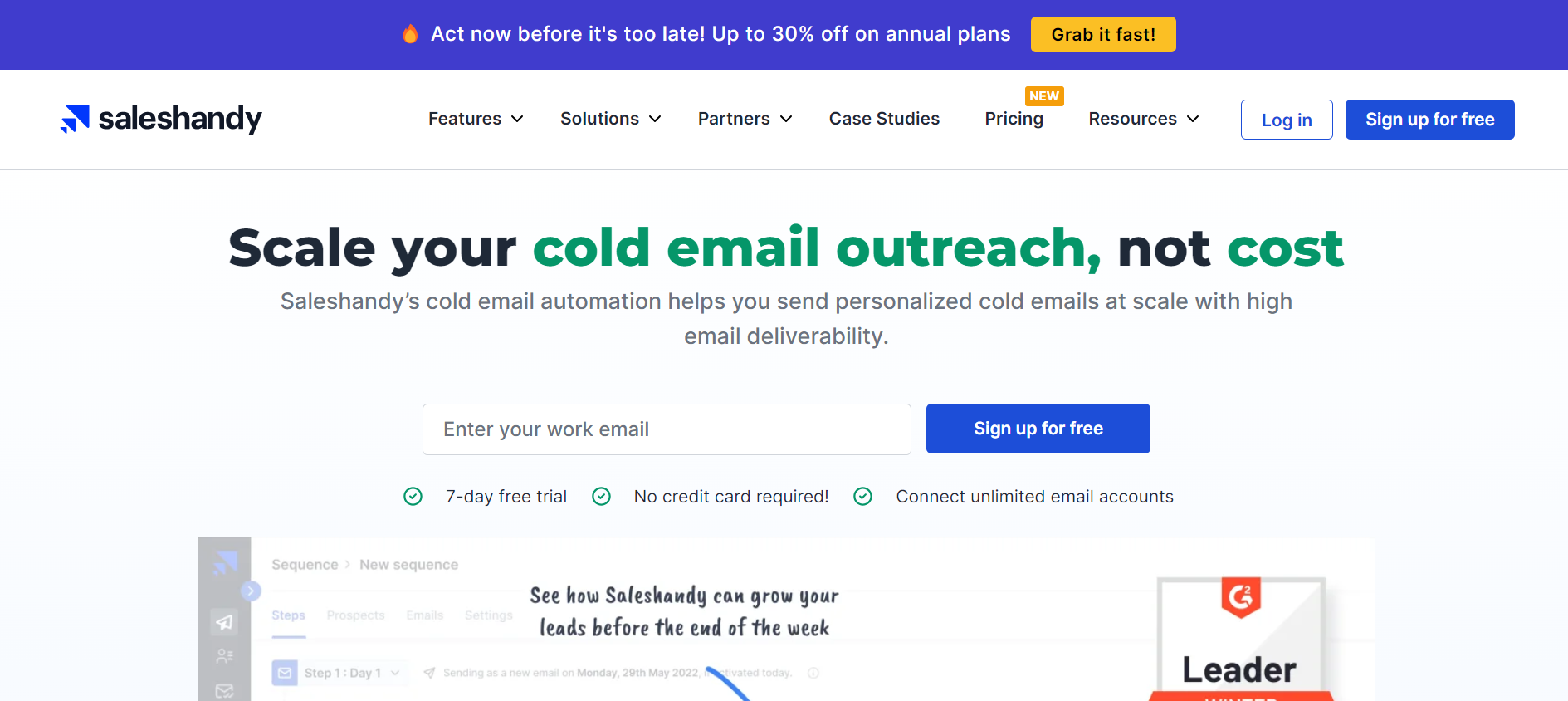Email is an indispensable tool for anyone looking to grow their business online. But if you want to maximize ROI on your email outreach efforts, it’s critical to track engagements on each email you send. But how do you...
Email is an indispensable tool for anyone looking to grow their business online.
But if you want to maximize ROI on your email outreach efforts, it’s critical to track engagements on each email you send.
But how do you really know if your prospects are opening and reading your emails?
This is where email tracking tools come in handy.
These tools give you insights into important metrics such as email open rates, click rates, response rates, and more.
With this data, you can understand how your emails are performing and make the required improvements to boost the performance of your cold email campaigns.
But with so many email tracking software on the market, how do you decide which is the best?
We’ve created a revised list of the best email tracking tools, covering an overview, pros and cons, and customer ratings for each tool to help you make the right decision.
Email Tracking Tools – Table of Contents
Top 5 Email Tracking Tools – At-a-Glance ComparisonWhat is Email Tracking? What are Email Tracking Tools? Benefits of Email Tracking Tools20 Best Email Tracking Tools of 2024How to Choose an Email Tracking Tool?Email Tracking LimitationsConclusionFAQsTop 5 Email Tracking Tools – At-a-Glance Comparison
| Saleshandy |
• Real-time Email Tracking • Automated Follow-Ups • Unified Inbox • Sender Rotation • Sequence Score • Team Collaboratio |
• G2 – 4.6 / 5  • Capterra – 4.5 / 5  |
$25 per month |
| Snov.io |
• Email Tracking • Email List Management • Search Filters • A/B Testing |
• G2 – 4.5 / 5  • Capterra – 4.6 / 5  |
$39 per month |
| MixMax |
• Email Tracking • Email Scheduling • Email Sequence • Meeting Polls |
• G2 – 4.6 / 5  • Capterra – 4.5 / 5  |
$29 per month |
| Autoklose |
• Email Campaigns • Email Tracking • Detailed Analytics • Template Library |
• G2 – 4.6 / 5  • Capterra – 4.5 / 5  |
$49.99 per month |
| Respona |
• Email Finder • Email Personalization • Email Tracking • Automated Outreach |
• G2 – 4.9 / 5  • Capterra – 5 / 5  |
$197 per month |
What is Email Tracking?
Email tracking is the process of monitoring how your emails perform once you’ve sent them.
It gives you visibility into whether your recipients have opened your email, clicked on the link you included, or replied back.
Email tracking works by adding special tracking pixels in your email messages that notify you whenever your recipients open your emails.
Today, the majority of businesses rely on email tracking to gauge the performance of their email campaigns. These tools also help you understand what kind of emails your target audience likes.
What Are Email Tracking Tools?
Email tracking tools allow you to know when your recipients have opened your emails or interacted with them.
If you’re using email as your primary channel for lead generation and sales outreach, email tracking tools can help you understand its effectiveness.
This, in turn, allows you to follow up with your prospects strategically based on how they have interacted with your emails.
Most email tracking software comes with a straightforward UI and can seamlessly integrate with the major email service providers (ESPs).
In addition, email tracking tools also come with numerous helpful features such as:
Real-time notificationsLink & attachment trackingDetailed tracking reportsCRM integrationsWhat Are the Benefits of Email Tracking Tools?
As we just saw, email tracking tools provide powerful data and insights to improve your cold outreach efforts.
But, that’s not all.
In this section, let’s take a look at all the benefits of email tracking tools.
Benefit #1 – Find Out Who Opened, Clicked, and Replied to Your Emails
Email tracking tools show you in real time when and who opened your emails, helping you identify how many prospects engage with them.
Moreover, monitoring email opens can help you figure out which emails resonate best with your prospects and find the best times to send emails for better open rates.
With click tracking, you can also see your most and least clicked links so that you can refine your email content accordingly.
Lastly, tracking your email replies also allows you to prioritize leads and segments that require more effective follow-up and nurturing.
Benefit #2 – Identify Promising Leads and Follow-Up Strategically
Detailed email metrics like open rate, click rate, and reply rate help you quantify email engagement.
This is extremely helpful because it lets you identify your most active and interested prospects so that you can send your follow-up emails accordingly. This, in turn, helps you move your prospects further along the sales funnel.
With these tools, you can also check deliverability metrics like bounce and unsubscribe rates to discover less engaged or inactive leads.
Based on this data, you can remove them from your email list and shift your focus more on promising leads rather than wasting efforts on disengaged prospects.
Benefit #3 – Refine Your Email Copy with A/B Testing
Last but not least, email tracking tools also enable you to perform A/B tests. This means you can send variations of your email to a small segment of your prospect list.
For example, you can test different subject lines, opening statements, call-to-actions (CTA), and more. The email tracking tool will help to discover which version resonates best with your prospects.
Based on this, you can double down on what’s working to improve the overall effectiveness of your email.
Plus, you can also consider A/B testing different send times as well as days to find out the best time to reach out to your target audience.
20 Best Email Tracking Tools to Measure Your Campaign Performance
Now that you’ve learned what email tracking tools are and their benefits, let us now look at the best ones currently on the market.
SaleshandyMailtrackNeoMySignatureYeswareRight InboxSalesBlinkSnov.ioAtomic Email TrackerMixMaxStreak for GmailMailtag.ioResponaCirrus InsightHubSpot Email Tracking SoftwareAutokloseVeloxyVocus.ioOpenedOrNot Mailbutler1. Saleshandy
Saleshandy is a leading cold email software with detailed email tracking capabilities. It gives you cold email automation and tracking features in one solution, instead of juggling between two different tools.

With Saleshandy, you can set up an entire cold email sequence with auto follow-up emails to scale your outreach efforts. Plus, the tool also lets you track cold email opens, clicks, and replies within the platform.
This can help you measure how many prospects are engaging with your emails and adjust your follow-up strategy according to the responses.
Let’s take a quick look at Saleshandy’s key features to understand how it can take your cold emailing game to the next level.
Key Features of Saleshandy:
Merge Tags – With Merge Tags, you can automatically add your prospect’s first name, last name, company name, and other details to your emails. Spintax – With Spintax, you can create multiple variations of the same text within an email. When you use this feature, each prospect receives a slightly different version. Auto Follow-Up – The Auto Follow-Up feature automatically sends follow-up reminder emails to your prospects. This saves you time from having to manually track and send reminders yourself. Sender Rotation – The Sender Rotation feature allows you to connect multiple email accounts and rotate them randomly when sending emails. This can prevent your emails from being flagged as spam since they are sent from different email accounts. Sequence Score – Saleshandy gives you a Sequence Score to assess how effective your email sequences are based on three factors: Email Setup, Sequence Setup, and Email Copy. In this section, you can also find useful tips to improve your Sequence Score. Unified Inbox – With the Unified Inbox, you can check all your replies from your email campaign in one place. This eliminates the need to check multiple inboxes to keep track of prospects’ responses. A-Z Testing – The A-Z Testing feature lets you create 26 different versions of an email by substituting letters A-Z in parts of the content.








![10 Best GMass Alternatives 2024 [Revised List!]](https://www.saleshandy.com/blog/wp-content/uploads/2022/08/Saleshandy-homepage.webp)



